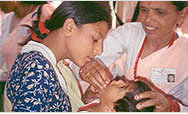FrontLines:
Spacing Children 3 to 5 Years Apart Is Best
March 2004
From Nigeria’s crowded cities to India’s teeming villages and everywhere between, health workers are sending out a new educational message: “Wait three to five years before having another child.”
Up to now, USAID had espoused a two-year waiting period between births.
But an intensive literature review on birth spacing suggested otherwise. As a result of studies that ended in 2002, the Agency will roll out awareness campaigns in countries where the Office of Population and Reproductive Health of the Bureau for Global Health is active.
Foreign governments are already amenable to birth spacing. In Nigeria, for instance, the Ministry of Health is encouraging families to space births. The message is carried on posters and broadcast advertising. Some posters read: "Well-spaced children are every parent's joy... for the love of your family, go for child spacing today."
In India, educational posters suggest that couples wait three years before having a second child. In Nepal, posters urge couples to wait until their child is in school before having another.
The campaigns are the result of extensive USAID-funded studies that show that spacing births three to five years apart cuts the mortality rate for infants and young children by 20–30 percent. Allowing time between births also makes it more likely that mothers will survive and be healthy.
The potential public health impact is huge. In the developing world, an estimated half million women and 10 million infants die annually from preventable, pregnancy-related causes.
USAID is preparing to recommend that counseling and education programs let people know that birth intervals of 3 to 5 years are best for mothers and children. The Agency is also rolling out a training program for non-governmental organizations and health providers on how to counsel clients on birth spacing.
During the studies, researchers held discussions with women throughout Latin America and India. At one meeting in Peru one woman said, “The woman gets sick because her body gets worn out when she has children close together.”
“The woman suffers if she has children close together,” another chimed in.
Currently, more than half the mothers in 55 developing countries wait less than three years between births. Another 26 percent space births less than two years apart. Almost everywhere, the studies found, birth intervals are shorter than women prefer.
The studies were conducted by ORC Macro analysts, who used the latest Demographic Health Survey data from 17 countries and took into account factors such as education and income.
The studies concluded that birth intervals of three years or longer substantially decrease mortality and nutritional risks, compared with intervals of two years or less. In developing countries, three-year birth intervals were associated with fewer stillbirths, prenatal deaths, and newborn deaths, and reduced the risk of stunted and underweight infants.
Access the March
2004 edition of FrontLines
[PDF, 2MB].
|


